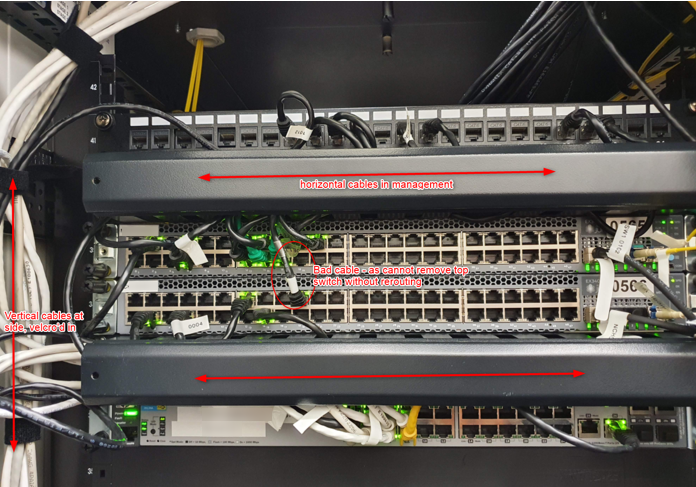Keep it tidy
We all love a bit of Cable Porn, a well structured and cabled datacenter center is a sight to behold.
But it doesn't need to go that far. Some of these beauties are so rigid that any change to rack configs requires a complete rebuild - cables are terminated to exact lengths, cable ties lock everything in place.
That may be fine for large scale deployments where we run rack at a time, but in the real world here are a few simple guidelines to keep things tidy.
Clear and concise physical cabling layout and labelling makes deployed infrastructure easier to work on, and neat cabling ensures that there is lower risk of disconnects during physical datacenter work.
Cable labelling should mean that racks are ‘self-documenting’, and separate cabling documentation is not required. This only ends up being out of date.
Principles
- Use Velcro – not cable ties to secure cables (these are living racks, and equipment will need to be moved/replaced).
- Cables should be run from the device to the side rear rack in the same RU space.
- Patch cables/Power cables should not run over the front of equipment (airflow and see below).
- Any device should be able to be removed without requiring cables to be rerouted.
- Use premade/ pre terminated patch leads. Don’t cut to length. Any benefits you get here with custom lengths are outweighed by the lack of flexibility and the quality of the connection.
- Cables should have sufficient slack to allow for some movement, but not so much that that are great loops of cables in the racks.
- Any spare/slack should be coiled/velcro’d neatly at the sides.
- Fibre cables should be routed following minimum bend radius requirements.
- Use appropriate overhead cable trays

Guidelines
- Label both ends of the cable. Preferably with Brady wrap around labels, but flappy flags OK
- Cat6/DAC. Don't go mad on the colours. We use black for data.
- Fibre. Use Singlemode where possible for data, Multimode for Fibre Channel.
- Power cables/Data cables should not be bundled together. Ideally run data/power on different sides of racks (not possible when we have PDU on both sides)
- Power Cables should be black for A feed and a different for B feed. To be able to see at a glance that devices are correctly powered (where possible)
- Remove unused cables when equipment is removed. Don’t leave lose stuff in racks.
- Front to back cables – when required – should only be secured at accessible ends of the racks. i.e. no velcro ties down the side of the rack – just because it is accessible when you deploy, doesn’t mean it will be in the future.
(most cabling should be in the rear of the rack – rear facing switch ports, to match the normal location of data ports on servers/arrays)
A datacenter should be smart and tidy. Neat and clear cable runs makes networking reliable. But we don't want to go so far as to be inflexible and unable to change.
